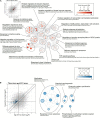Analysis of Age-Dependent Transcriptomic Changes in Response to Intracerebral Hemorrhage in Mice
- PMID: 35677585
- PMCID: PMC9169040
- DOI: 10.3389/fnmol.2022.908683
Analysis of Age-Dependent Transcriptomic Changes in Response to Intracerebral Hemorrhage in Mice
Abstract
Age is a well-known risk factor that is independently associated with poor outcomes after intracerebral hemorrhage (ICH). However, the interrelationship between age and poor outcomes after ICH is not well defined. In this study, we aimed to investigate this relationship based on collagenase-induced ICH mice models. After being assessed neurological deficit 24 h after ICH, mice were euthanized and brain perihematomal tissues were used for RNA-sequencing (RNA-seq). And then the functions of differentially expressed genes (DEGs) identified by RNA-seq were analyzed using Gene Ontology (GO) analysis, Kyoto Encyclopedia of Genes and Genomes (KEGG) analysis, Ingenuity Pathway Analysis (IPA) and protein-protein interaction (PPI) analysis. In addition, we performed real-time quantitative polymerase chain reaction (RT-qPCR) for validation of candidate DEGs. In the behavioral tests, aged mice presented significantly worse neurological function than young mice and greater weight loss than aged sham controls 24 h after ICH. In DEGs analysis, ICH affected the expression of more genes in young mice (2,337 DEGs) compared with aged mice (2,005 DEGs). We found aged mice exhibited increased brain inflammatory responses compared with young animals and ICH induced significant activation of the interferon-β (IFN-β) and IFN signaling pathways exclusively in aged mice. Moreover, further analysis demonstrated that ICH resulted in the activation of cytosolic DNA-sensing pathway with the production of downstream molecule type I IFN, and the response to type I IFN was more significant in aged mice than in young mice. In agreement with the results of RNA-seq, RT-qPCR indicated that the expression of candidate genes of cyclic GMP-AMP synthase (cGAS), Z-DNA-binding protein 1 (ZBP1), and IFN-β was significantly altered in aged mice after ICH. Taken together, our study indicated that compared to young animals, aged mice exhibit increased vulnerability to ICH and that the differences in transcriptional response patterns to ICH between young and aged mice. We believe that these findings will facilitate our understanding of ICH pathology and help to translate the results of preclinical studies into a clinical setting.
Keywords: aging; inflammation; intracerebral hemorrhage; neurological deficit; transcriptomics; type I interferon.
Copyright © 2022 Li, Yang, Shen, Liu, Xiong, Wu, Xiao, Yang, Dang, Manaenko, Xie and Li.
Conflict of interest statement
The authors declare that the research was conducted in the absence of any commercial or financial relationships that could be construed as a potential conflict of interest.
Figures







Similar articles
-
Identification of hub genes and small-molecule compounds related to intracerebral hemorrhage with bioinformatics analysis.PeerJ. 2019 Oct 25;7:e7782. doi: 10.7717/peerj.7782. eCollection 2019. PeerJ. 2019. PMID: 31667013 Free PMC article.
-
Intracerebral hemorrhage induces monocyte-related gene expression within six hours: Global transcriptional profiling in swine ICH.Metab Brain Dis. 2019 Jun;34(3):763-774. doi: 10.1007/s11011-019-00399-z. Epub 2019 Feb 22. Metab Brain Dis. 2019. PMID: 30796715 Free PMC article.
-
Identification of Candidate Blood mRNA Biomarkers in Intracerebral Hemorrhage Using Integrated Microarray and Weighted Gene Co-expression Network Analysis.Front Genet. 2021 Jul 19;12:707713. doi: 10.3389/fgene.2021.707713. eCollection 2021. Front Genet. 2021. PMID: 34349791 Free PMC article.
-
Age-related changes after intracerebral hemorrhage: a comparative proteomics analysis of perihematomal tissue.Exp Biol Med (Maywood). 2024 Mar 25;249:10117. doi: 10.3389/ebm.2024.10117. eCollection 2024. Exp Biol Med (Maywood). 2024. PMID: 38590360 Free PMC article.
-
Preliminary Analysis of Aging-Related Genes in Intracerebral Hemorrhage by Integration of Bulk and Single-Cell RNA Sequencing Technology.Int J Gen Med. 2024 Jun 12;17:2719-2740. doi: 10.2147/IJGM.S457480. eCollection 2024. Int J Gen Med. 2024. PMID: 38883702 Free PMC article.
Cited by
-
Examining Transcriptomic Alterations in Rat Models of Intracerebral Hemorrhage and Severe Intracerebral Hemorrhage.Biomolecules. 2024 Jun 11;14(6):678. doi: 10.3390/biom14060678. Biomolecules. 2024. PMID: 38927081 Free PMC article.
References
-
- Askenase M. H., Goods B. A., Beatty H. E., Steinschneider A. F., Velazquez S. E., Osherov A., et al. (2021). Longitudinal transcriptomics define the stages of myeloid activation in the living human brain after intracerebral hemorrhage. Sci. Immunol. 6:eabd6279. 10.1126/sciimmunol.abd6279 - DOI - PMC - PubMed
LinkOut - more resources
Full Text Sources
Molecular Biology Databases
Research Materials

